Clark reports on the experience of his family eating at Hojo’s Japanese Cuisine, a new restaurant “in the old Pat & Willys.”
As is the case with most restaurants in Charlottetown, the cost was about 2-3x the price of a similar meal in Hsinchu, but unlike the “fries-with-that” places that litter the city, it’s a worthwhile treat.
Relative to 25 years ago, when we arrived here in Charlottetown, the proportion of “fries-with-that” restaurants has dramatically decreased; there was a time when that was almost all you could get if you ate out.
Today, within walking distance of my office I can get bibimbap at three different places; we have two Vietnamese restaurants, three Thai restaurants, and three Indian restaurants. Our 1993 selves wouldn’t recognize the place.
I first met Jeff Eagar when the PEI Home and School Federation hired him to shoot and edit a short film about the Island’s universal provincial school food program.
Tonight, as I was waiting to pick up our food at Richard’s, Jeff said hello, and we had a chat.
He was just back from India, he told me, a trip planned in part to recognize the 20th anniversary of Bang7, a holiday that Jeff invented in 1999 with his brothers, and that they–and an increasing number of their friends and familiars–have celebrated every year since.
Happiness. Good health. Love. These are simple concepts buried under skinny jeans, social media hashtags and shiny, new cell phones. Society is lost in a culture fixated on possessions, appearance and impatience. Contentment seems illusive in today’s manic and ‘wired’ world. It’s a problem that affects nearly all of us and it’s this reason that 20 years ago us brothers created the unique holiday Bang 7 – Life Day.
Twenty years ago in the tiny remote town of Pushkar in the Rajasthan desert of western India us brothers decided we needed something that would remind us of what is actually important in life. We needed something that would keep us grounded and remind us of what truly makes us happy. We had been travelling through India for months with little more than a backpack and a few basic provisions, but we were happy, healthy and content; a simple and fulfilling existence. Sunsets had beauty, food had flavour, conversations with strangers were fun. So on June 7th, back in 1999, in a wonderful moment of simplicity and clarity, we created Bang 7 – Life Day in order to never forget what life is truly about. Since that day, every year on the 7th of June, we have been taking that day to celebrate life, love, our health and the people around us. In addition, we have been sharing the celebration with as many people as we can around the world. Whether you are Indian, American or Japanese, regardless if you’re black or white, female or male, Sikh or Christian it’s all the same, Bang 7 is for everyone.
Given the spirit of Bang7, it’s kind of appropriate that I reconnected with Jeff at Richard’s: a visit there is one of Catherine’s favourite summertime things to do, and yet our last time there was in August of 2016, two years ago.
There are myriad reasons for our long absence: some, like “when you’re on chemo everything tastes like metal” are completely understandable.
But there’s also a good dose of forgetting to do the things that really matter that was responsible, and I’m happy that we took the effort today, and thus got a reminder of “what is actually important in life.”
I’m happy to report that Richard’s is better than ever–with the long lines to match: the fish and chips were simply fantastic, the sun was shining, and the summertime vibe everywhere.
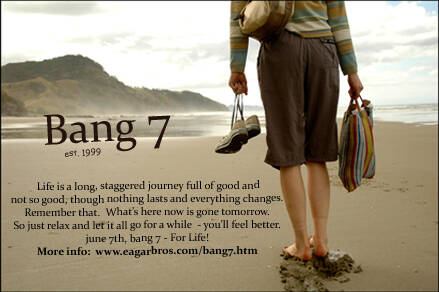
In Google Maps you can click on any point of interest on the map to see details and, optionally, you can click “Save” to save the point for later reference.
When you click “Save” you’re presented with a list of options: Favorites, Want to go, Starred places, plus any lists you’ve created previously:
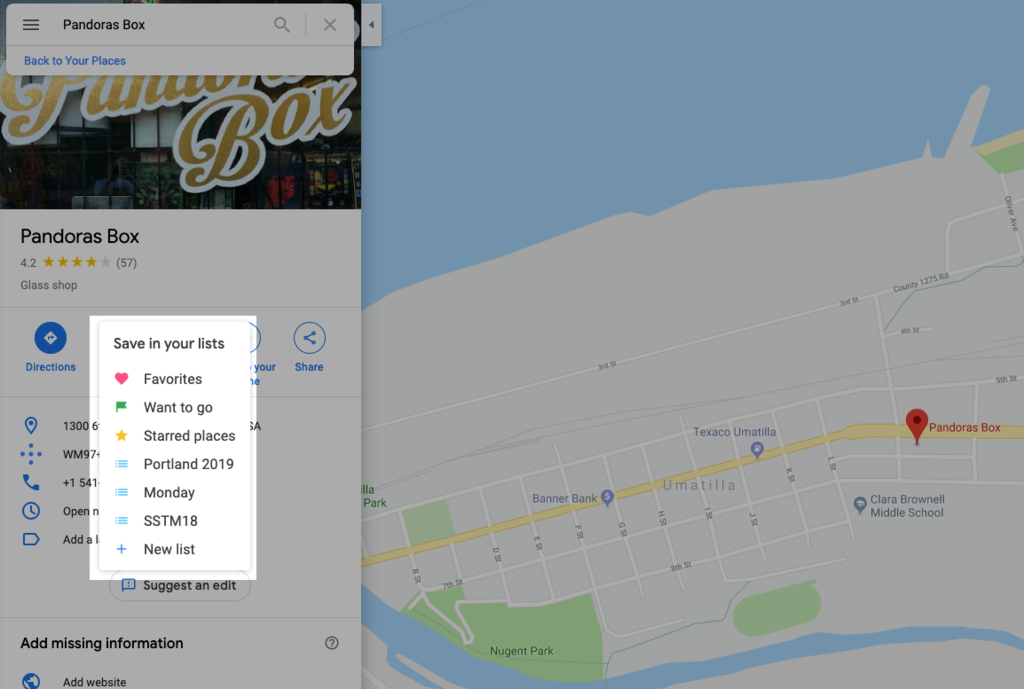
You might imagine, because of the way they’re presented, that each of these options simply represents a co-equal category in the “Your Places” section in Google Maps, and certainly the way the lists are presented there suggests this is the case:
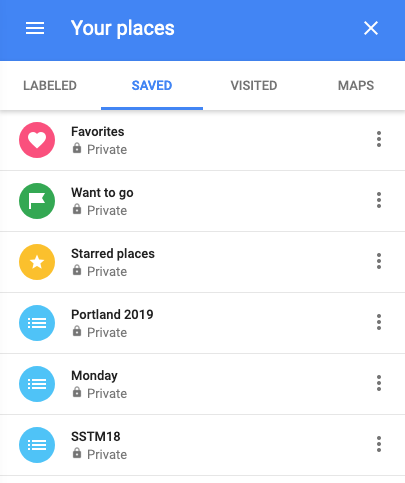
It turns out, however, that under the hood, at least as far as your ability to export your places using Google Takeout is concerned, these are very different categories.
Starred places
The Starred places list is exported from Google Takeout via the Maps (your places) export:

The list that gets exported as a result is a GeoJSON file with each starred place represented like this:
{
"geometry" : {
"coordinates" : [ -0.1305119, 51.5109554 ],
"type" : "Point"
},
"properties" : {
"Google Maps URL" : "http://maps.google.com/?cid=14538551136252988017",
"Location" : {
"Address" : "5-6 Leicester Square, London WC2H 7NA, United Kingdom",
"Business Name" : "Cineworld Cinema - London Leicester Square",
"Country Code" : "GB",
"Geo Coordinates" : {
"Latitude" : "51.5109554",
"Longitude" : "-0.1305119"
}
},
"Published" : "2016-05-15T16:32:36Z",
"Title" : "Empire Cinema",
"Updated" : "2016-05-15T16:32:36Z"
},
"type" : "Feature"
}
That’s about as much information as I’d ever want about a starred place, and it’s very helpful to have.
Everything else
Everything else–Favorites, Want to go, plus any lists you’ve created previously–is available from Google Takeout via the Saved export:

These places cannot be exported as a helpful GeoJSON file, only as a CSV, and the CSV only contains the title of the saved place, any note you added, its Google Maps URL and any comments:
Title,Note,URL,Comment
Cyclesmith,,https://www.google.com/maps/place/Cyclesmith/data=!4m2!3m1!1s0x4b5a222a1bfe6b69:0xf8fad3e13f099e36,
3660 Strawberry Hill St,,https://www.google.com/maps/place/3660+Strawberry+Hill+St/data=!4m2!3m1!1s0x4b5a21095c7e943b:0xcaafa3916fb4a0e6,
Sportwheels Sports Excellence,,https://www.google.com/maps/place/Sportwheels+Sports+Excellence/data=!4m2!3m1!1s0x4b5988577cfca89f:0x7002bb9c32866180,
The eBike Centre Halifax,,https://www.google.com/maps/place/The+eBike+Centre+Halifax/data=!4m2!3m1!1s0x4b5a2367215d4d2b:0x51aa4206ac656daf,
Dragon E Bikes Ltd,,https://www.google.com/maps/place/Dragon+E+Bikes+Ltd/data=!4m2!3m1!1s0x4b5a21a86a32afe3:0xc6fe4d5ec596b038,
There’s no geographical information in the file.
If you’ve been treating Google Maps’ ability to save places as a way of building up a list of places that you later hope to use in some other system, you’ll want to consider only saving to the Starred places list, as it provides the greatest flexibility for later export.
Cory Doctorow writing about Facebook in 2018:
Facebook isn’t a mind-control ray. It’s a tool for finding people who possess uncommon, hard-to-locate traits, whether that’s “person thinking of buying a new refrigerator,” “person with the same rare disease as you,” or “person who might participate in a genocidal pogrom,” and then pitching them on a nice side-by-side or some tiki torches, while showing them social proof of the desirability of their course of action, in the form of other people (or bots) that are doing the same thing, so they feel like they’re part of a crowd.
Maciej Cegłowski writing in 2016 from Antarctica:
The usual dynamic between locals and tourists is backwards in the Ross Sea. Everywhere else in the world, tourists are the ones ruining everything, showing up in hordes, drinking hard, contributing nothing but money to whatever place they’ve chosen to culturally strip-mine for their entertainment. The locals have to struggle to reclaim the quiet life that attracted the tourists in the first place, and their connection to home is eroded by having to role play for a changing cast of strangers. Regrettable t-shirts are printed and sold. A Señor Frog’s opens. It’s grim.
Here, though, the tourists are the ones keeping it real. McMurdo is a scar on the landscape, the least natural place in Antarctica, and most of the people working here are seasonal transients. They come down for a sense of adventure, clean grease traps for six months in a windowless building, and go back to where they came from. The only natives in Antarctica are penguins, and you can spend years at the American base without seeing one of them.
I’ve been experimenting with Termux on my Moto G7 Play. While my route in was looking for a terminal emulator for the phone, I’ve since discovered that Termux us much, much more than that.
For example, I can run Node-RED on my phone via Termux, which gives me a rich visual programming tool for wiring up inputs to outputs.
What kinds of inputs, you ask?
Well, via Termux: API, I gain access to all of the sensors on my phone. And it turns out there are a lot of them:
# termux-sensor -l
{
"sensors": [
"LSM6DSM Accelerometer",
"MMC5603NJ Magnetometer",
"MMC5603NJ Magnetometer Uncalibrated",
"LSM6DSM Gyroscope",
"LSM6DSM Gyroscope Uncalibrated",
"EPL259x ALS\/PS PROX",
"EPL259x ALS\/PS ALS",
"LSM6DSM Accelerometer -Wakeup Secondary",
"MMC5603NJ Magnetometer -Wakeup Secondary",
"MMC5603NJ Magnetometer Uncalibrated -Wakeup Secondary",
"LSM6DSM Gyroscope -Wakeup Secondary",
"LSM6DSM Gyroscope Uncalibrated -Wakeup Secondary",
"EPL259x ALS\/PS PROX -Non Wakeup Secondary",
"EPL259x ALS\/PS ALS -Wakeup Secondary",
"Gravity",
"Linear Acceleration",
"Rotation Vector",
"Step Detector",
"Step Counter",
"Significant Motion Detector",
"Game Rotation Vector",
"GeoMagnetic Rotation Vector",
"Tilt Detector",
"Android Stationary Detector",
"Android Motion Detector",
"Gravity -Wakeup Secondary",
"Linear Acceleration -Wakeup Secondary",
"Rotation Vector -Wakeup Secondary",
"Step Detector -Wakeup Secondary",
"Step Counter -Wakeup Secondary",
"Game Rotation Vector -Wakeup Secondary",
"GeoMagnetic Rotation Vector -Wakeup Secondary",
"Chop Chop Gesture",
"Moto Glance Gesture",
"Camera Gesture",
"Stowed",
"Display Rotate",
"Flatup",
"Flatdown",
"LTS Gesture",
"FTM Gesture",
"LTV Gesture",
"Off Body",
"capsense_top",
"capsense_bottom"
]
}
Lots more experimenting to do now!
Colourful men’s shoes don’t come along everyday. And so when I needed to replace the leaky shoes this afternoon, these jumped off the shelf at me.
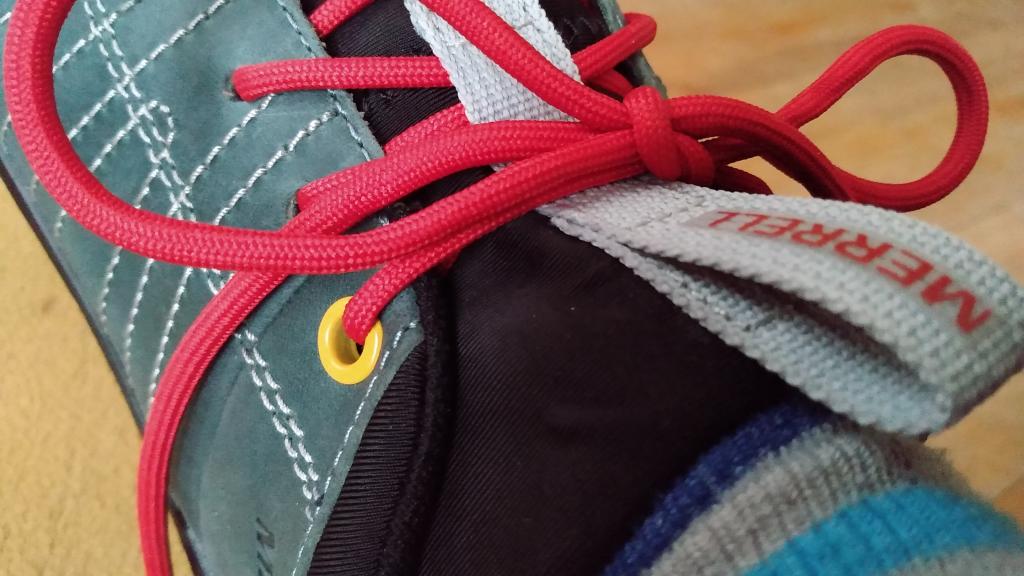
I’m fairly certain that I went to my high school graduation, but I’m sure.
I had a complex end to high school: although I spent the first four years of the (then-five-year, including grade 13) experience at Waterdown District High School, doing my final year at the Ontario Science Centre Science School meant that I technically graduated from the nearby Don Mills Collegiate Institute in Toronto. That said, I have a memory of being allowed to join my peers at WDHS for the final graduation (as well as a memory that my brother Mike and I, independently, each opted out of wearing a gown to do so). But those memories are vague, and I may have made the whole thing up.
Oliver, however, did graduate from high school this week: I know this both because I was there, and because scenario-planning for the various and sundry ways that the perfect storm of crowded anxiety-ridden events could go sideways has consumed my spare thoughts for most of the last couple of months.
But it didn’t go sideways: thanks to a combination of a formidable effort by Oliver to keep calm, a lot of advance planning and practice, and a well-executed event, it all went off without a hitch.
Derrick Comes to Town
One of the best things that ever happened to Oliver is that, as he entered grade 9, Derrick Biso came into his life as an after-school and summertime support worker. Over three years Derrick and Oliver developed a strong bond, and there are few people in the world Oliver trusts more.
Unbeknownst to us, Oliver had invited Derrick to come back to the Island for the graduation and Derrick blessedly agreed. And so Derrick has been here all week: they went to prom together on Tuesday, Derrick sat beside Oliver at graduation, and they went to the “safe grad” activities afterwards. Everyone should be so lucky as to have someone like Derrick in their lives, and that Oliver’s week went as well as it did is due in part to Derrick’s presence.
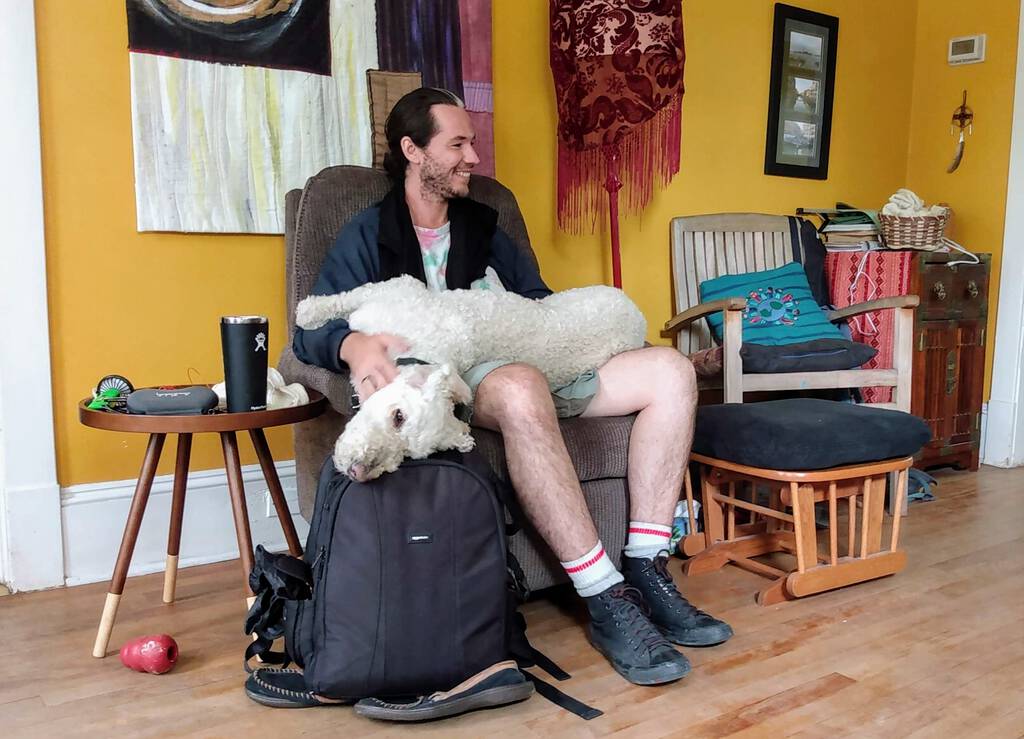
The Morning Run-Thru
We started the day at the Chi-Wan Young Sports Centre at the University of PEI (where all the Charlottetown-area high schools hold their ceremonies, so as to accommodate all of the students, teachers, staff, families and guests at the same time). We met Shelly Mann (the Inclusive Education Coordinator at Colonel Gray and Oliver’s educational spirit guide), Dave Morrow and Maritza Vessey (Oliver’s morning and afternoon educational assistants, respectively, for the last three years) in the gym so that Oliver could get the lay of the land, and do a practice walk across the stage.
It was a great idea to do that, as it meant that when he went to do the real thing, later in the afternoon, it was old hat.
With the run-through out of the way, we went home for a few hours of rest, some lunch, and to get dressed for the ceremony proper.
To the Ceremony in the Rain
As the day progressed the projected rain materialized. And the rain got heavier and heavier. Oliver and I left the house just before 1:00 p.m. to go to Colonel Gray to pick up his gown, and then back to UPEI for 1:30 p.m. Although we were relatively early, the parking lot was already full enough that we had to park in the back-back and wade through a torrent of water to get inside (it was during this walk that I reconfirmed that my shoes had holes in them).
Walking into the gym we were greeted by Enes Alisic, who’d taught Oliver’s political science class last semester (and who proved to be a kind and estimable educator who developed a strong connection with Oliver).
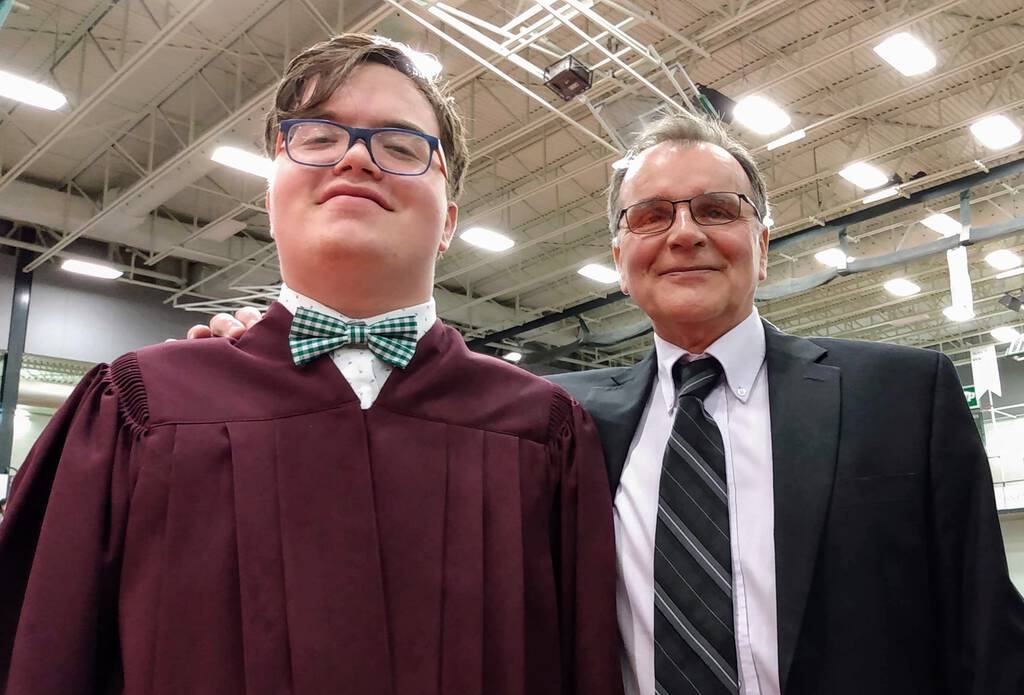
Oliver chose to wear a variation of his prom outfit from earlier in the week: blue-checked shirt and green bow tie, both from Winners (really the only store in Charlottetown to shop at if your son tells you that he needs to dress like it’s 1929).
Close to 2:00 p.m. we took our seats, helpfully located in close proximity to the stage:
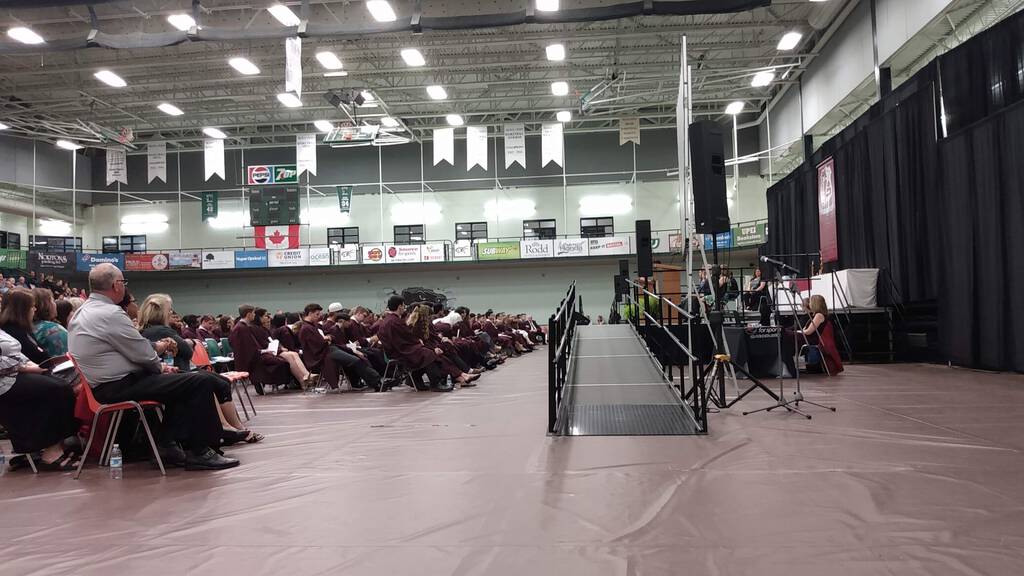
Blah Blah Blah
Oliver and I, the day before, had worked out a play-by-play schedule for the day so that he could know what to anticipate; because we didn’t have the exact schedule in-hand, there are a couple of lines in this schedule like:
Oliver returns to seat. Blah. Blah. Blah.
The graduation ceremony started with a lot of blah blah blah: graduates walk in en masse, O Canada, greetings from Public Schools Branch, greetings from the Government, Principal’s address. It then segued into the presentation of “major awards” – scholarships and prizes from universities and colleges. The organizers deserve credit for breezing through this quickly, and ensuring that if one student received multiple awards, they only ascended the stage once.
The blah blah blah finished with a rendition of Stand By Me by a talented group of students.
Presentation of Diplomas (and Catherine Arrives)
The first hill to climb for Oliver was to received his diploma: this was done in alphabetical order, and, as anyone with a later-alphabet name can attest, this meant a lot of waiting.
Because we knew that sitting on hard plastic chairs would wreak havoc on Catherine’s back, we’d arranged with our friend BJ to whisk her up to campus as soon as the alphabet started, safe in the knowledge that, with 265 graduates to get through, she’d have enough time to get there and take her seat. This worked like a charm, and by the time she was ready and seated they were still working through the Gs.
Oliver Takes the Stage
Here’s how the schedule described what came next:
At Oliver’s alphabetical time, Oliver and Dave walk from seats to stage. Ethan and Derrick and Peter and Catherine stay seated.
Oliver walks across stage, gets paperwork, shakes hands, photo taken, etc.
Oliver leaves stage to Shelly and Maritza on the other side, and returns to seat.
And that’s exactly what happened. The marshall-of-the-line helpfully opened up a spot for Oliver, pressing “pause” on the rest of the line, so that he didn’t have to wait an anxious eternity on the ramp up. Dave led him up to the stage, and he waited there for Julia Monique Robichaud (his alphabetical-predecessor), to receive her diploma:
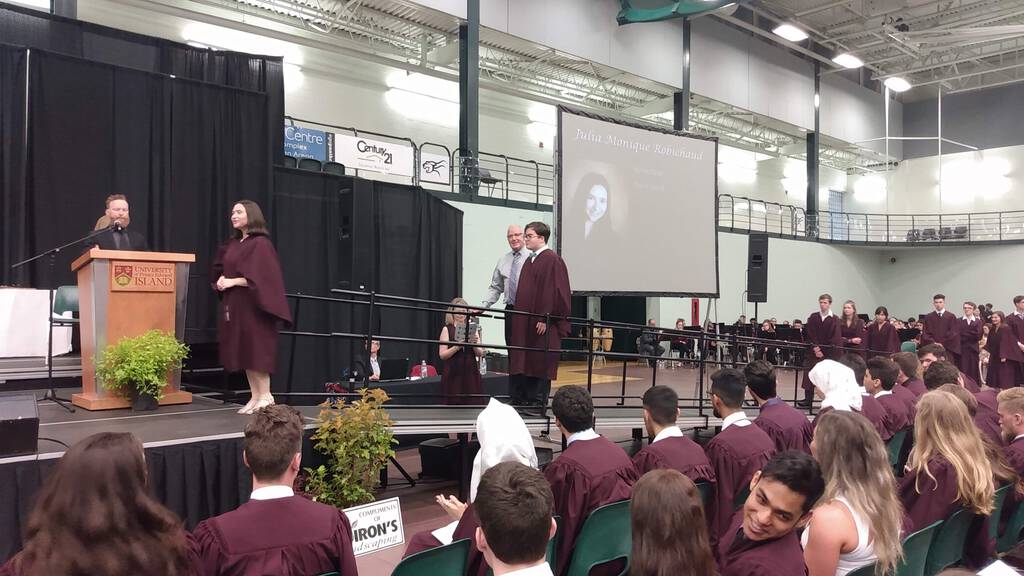
Then his name was called–Oliver Duncan Lowell Rukavina–and he simply aced the moves that came next:
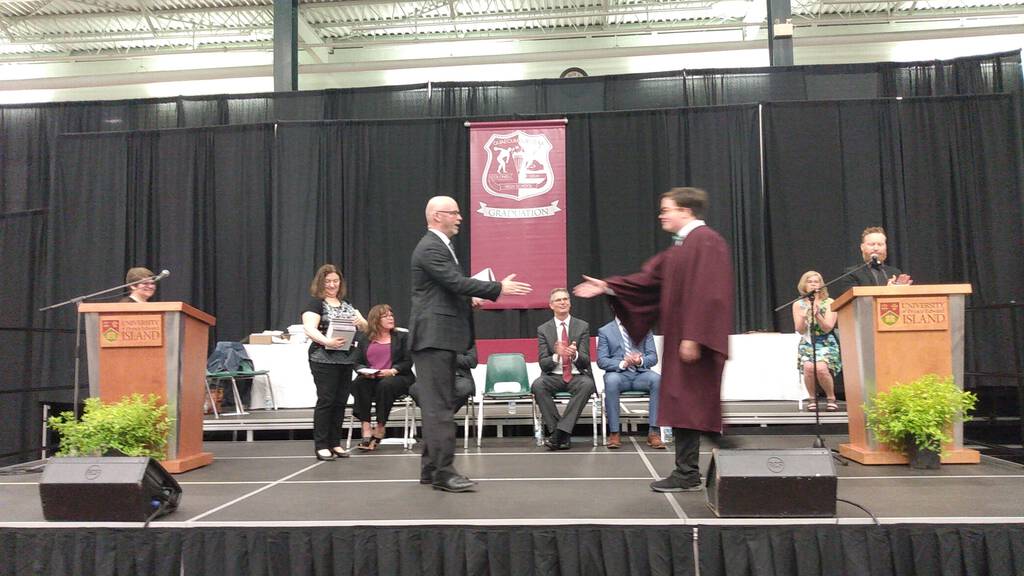
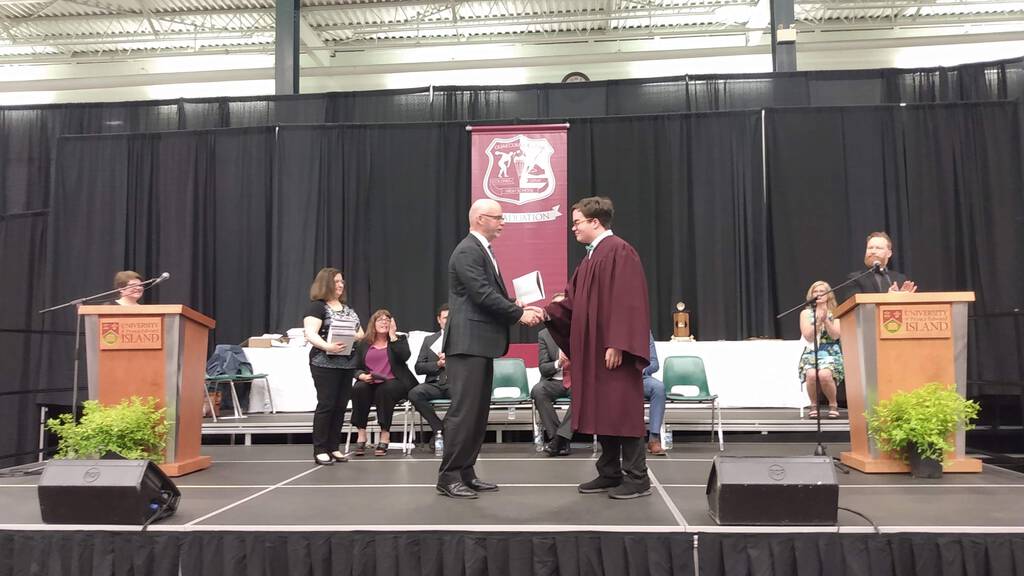
He looked around for me to take his photo:
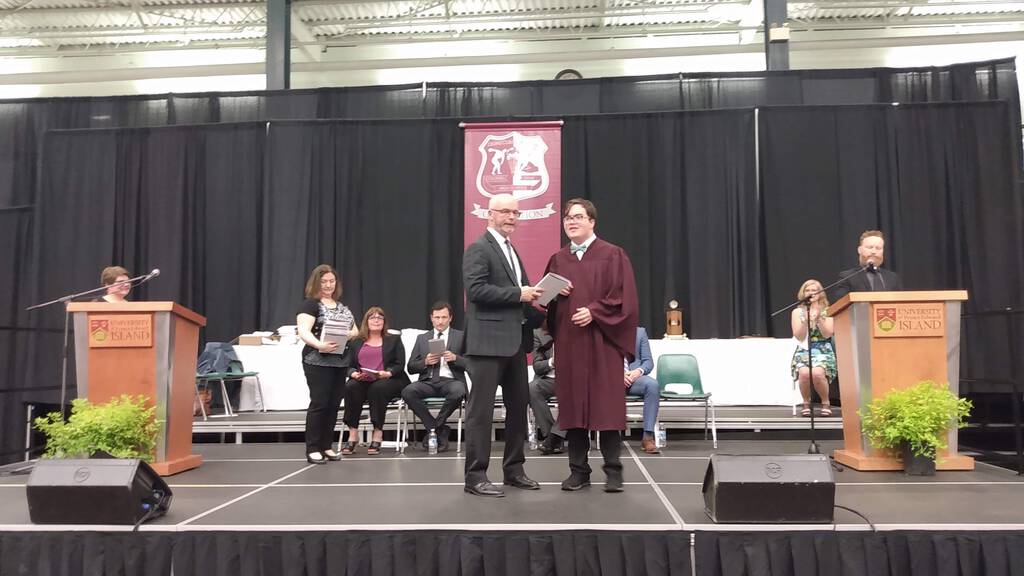
And, finding me, he posed for a photo (beside Dale Cole, the vice-principal):
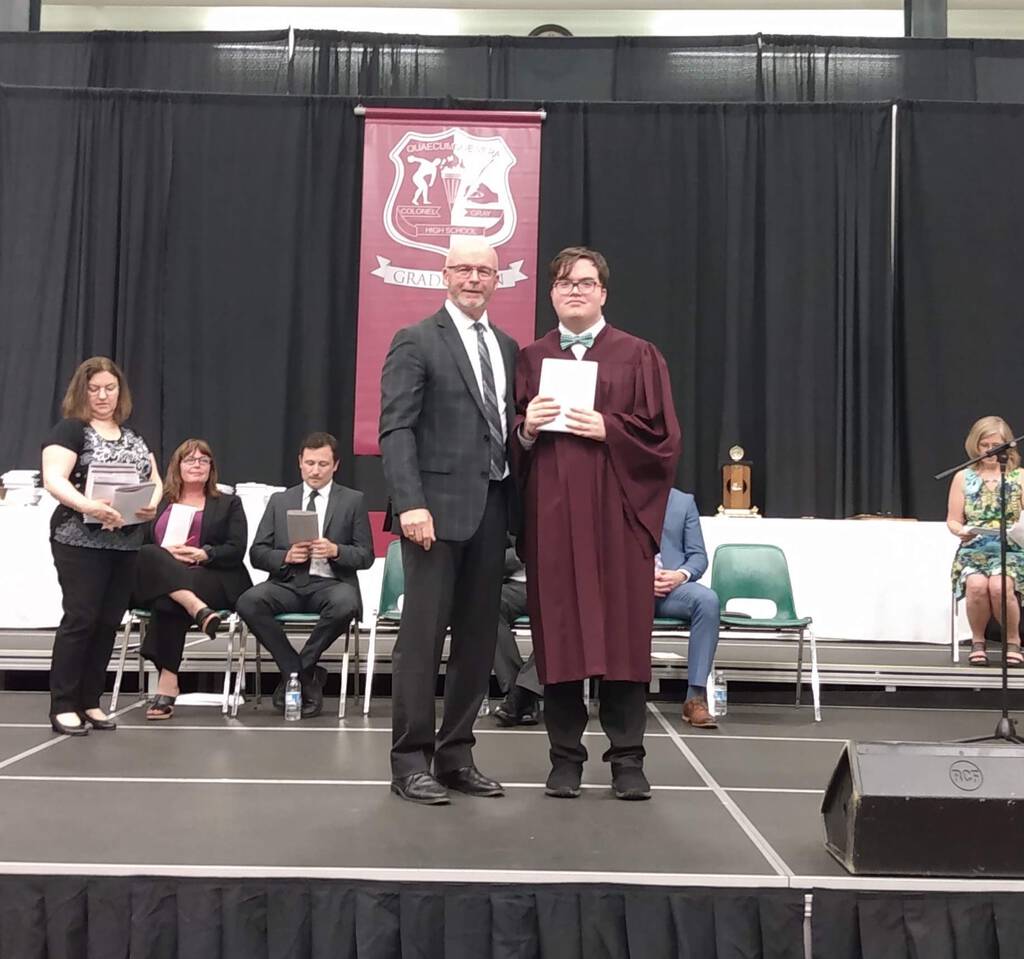
Presentation of Prizes
Although the recipients of various prizes are supposed to be kept secret, things being kept secret is a source of considerable anxiety for Oliver (which has made me extra-sensitive to how many secrets-involving rituals we have in our culture!). As such, forward-thinking Shelly Mann broke the rules and gave us a heads-up that Oliver would be receiving a “Staff Award.”
Hence the next section of our schedule:
Blah. Blah. Blah. Awards.
Oliver gets Staff Award announced: same Dave- stage- photo- handshake- Maritza & Shelly system again.
Oliver returns to seat.
The Staff Awards were described in the program as being presented to “graduating students, who in their years at Colonel Gray, have made contributions to student life and/or maintained academic standing and/or applied consistent effort.”

After a raft of other prizes and awards, Oliver and the other recipients of the Staff Awards were called to the stage and, per our arrangement, Oliver and Dave got themselves to the end of the stage, and I arranged myself in the official photograph-taking area. Because, well, Murphy’s Law, I ended up shooting a lovely video of his walk up to the stage and his receiving the award with my finger over the microphone of my phone, so it’s a silent movie. But a lovely life-affirming one:
The Valedictory Address
Once all the awards were awarded, Cole Gallant, the valedictorian, took to the podium to deliver his address. Toward the end the students all stood up for the big finale, and Oliver stood up with them:
The End
Once the valedictory address was done, there were a few moments for photos.
Here’s Dave, Oliver, Maritza and Ethan:
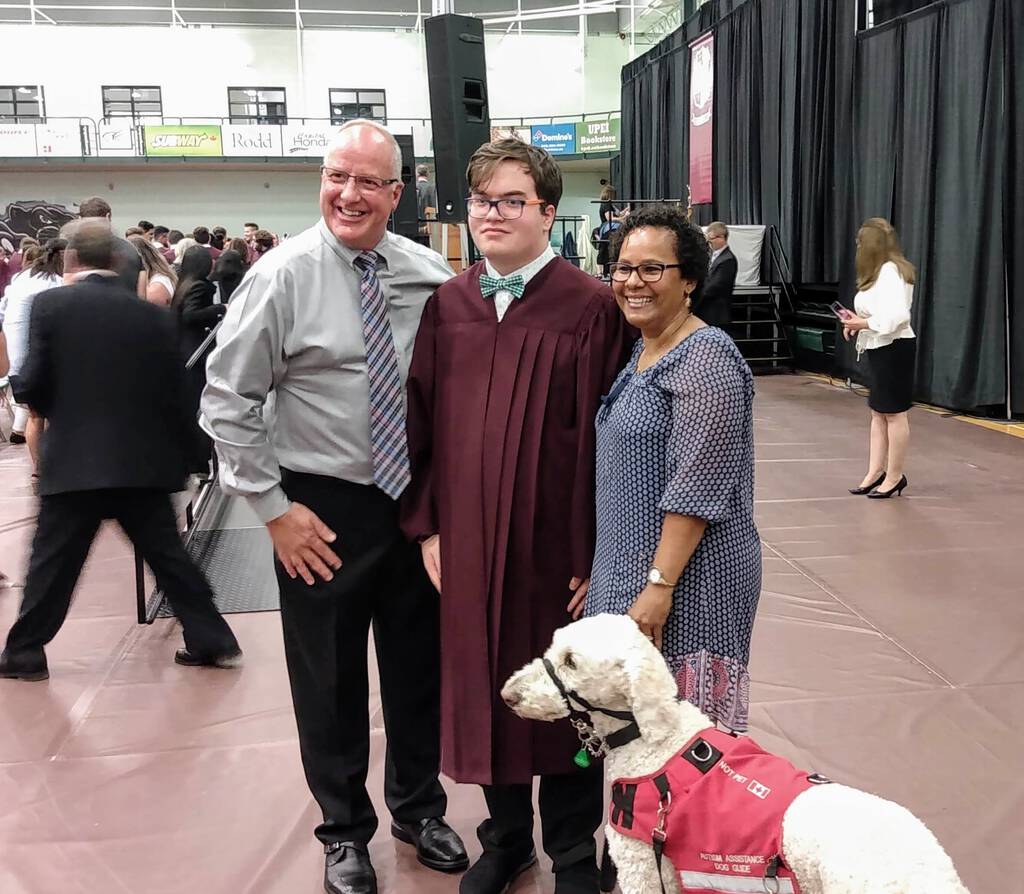
And here’s Catherine, me, Oliver and Derrick:
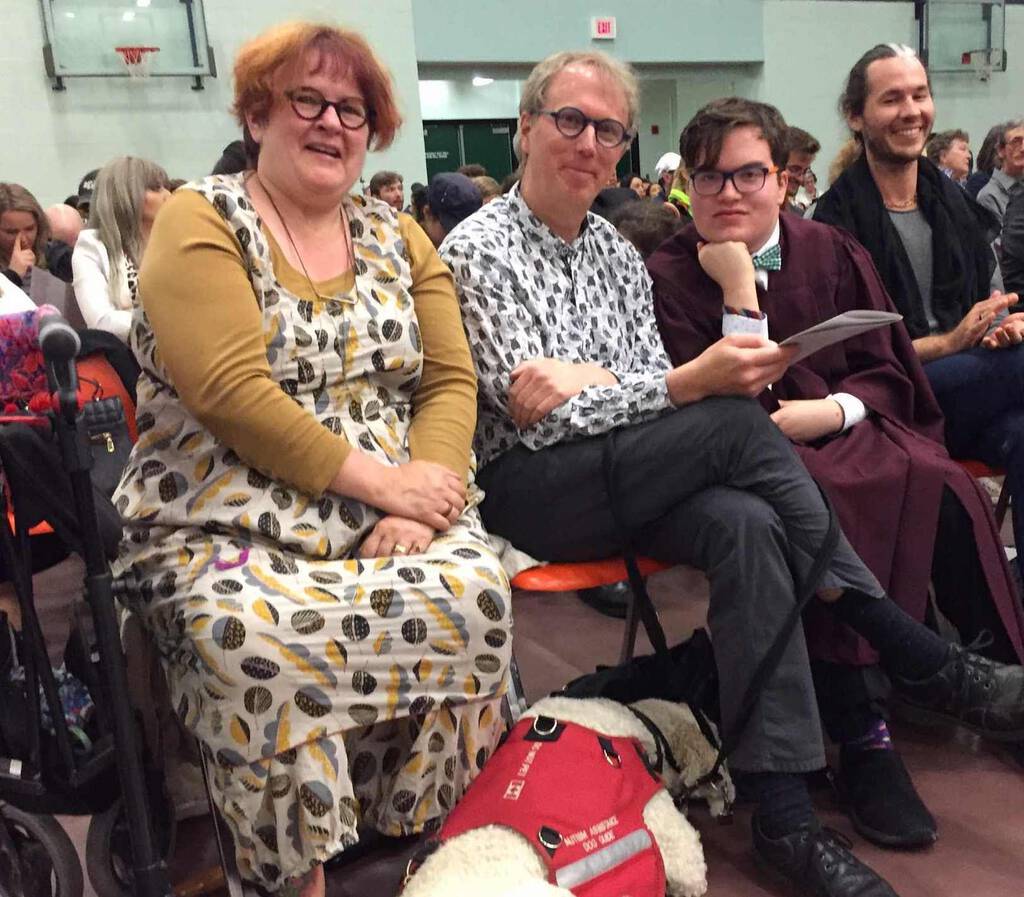
I darted back out into the rain to get Oliver’s change of clothes, pulled the car around for Catherine, and Oliver and Derrick headed off to the school for an evening of fun and frolic for the next six hours (did I mention the Derrick is amazing?).
Oliver, we are so, so proud of the young man you have become, and so proud of you for being able to successfully navigate yourself through what we know was a really, really hard day of stresses and triggers. You are amazing.
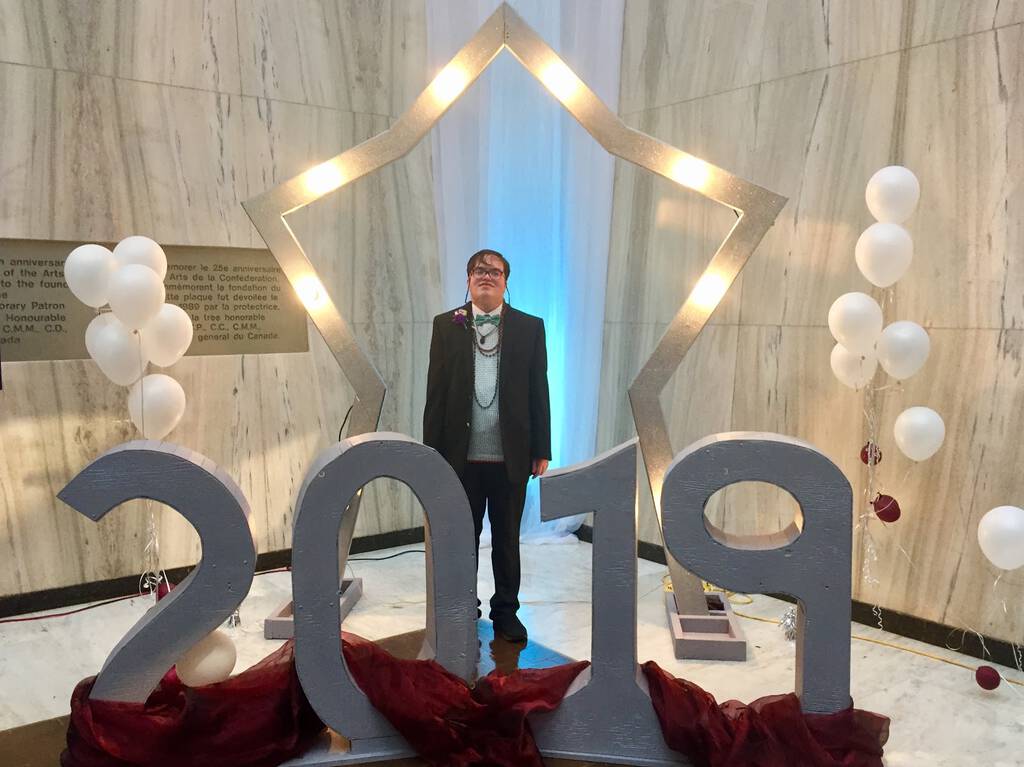
It is high school graduation day for Oliver, and we went up to the field house at the University of PEI this morning for a dry run of his walk across the stage. It was overcast when we entered; it was pouring torrential rain as we left, and so I learned that my shoes have holes, as they quickly filled up with water.
When I got back to the office an hour later the following conversation with the church sexton ensued:
Me: I learned today that my shoes have holes in them.
Him: I guess you’ll be making a trip to the store.
Me: They’re perfectly fine shoes, it’s just that the body has separated from the sole.
Him: There’s nothing worse than getting separated from your soul.
He is right.
Never have I have been so sheepish as when I got in my “dinosaur-powered” VW Jetta, after tonight’s PEI Electric Vehicle Association meeting, and rumbled off. While everyone else was alighting their silent electric cars and smoothly gliding home.

 I am
I am